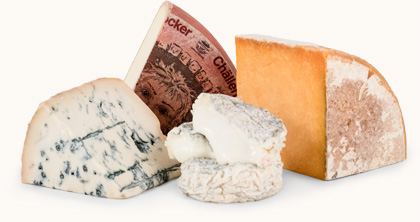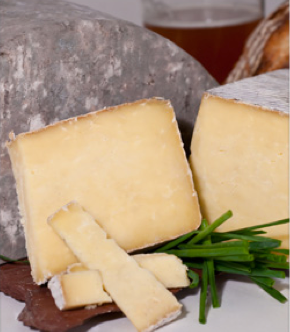To maintain the subtle flavors and aromas of gourmet cheeses, they should be sliced when you purchase them, and eaten soon after. Softer cheeses usually keep from one to three weeks. Hard cheeses may be fine for several months.
The key to cutting cheese is to divide cheese so that each piece has the same amount of inside and outside. Cut round cheeses like a cake. Cut slices lengthwise rather than across, and tall cheeses are easier to serve if sliced horizontally.
Most all cheeses keep best at 50-60° F which will allow the cheese to ripen properly. If you need to keep it longer without over-ripening, reduce the temperature to 35-40° F, but remove them 1 to 2 hours before serving to enhance their tastes and aromas. The flavor of cheese is best when eaten at room temperature.
Organisms in cheese are alive — cheese will continue to ripen, no matter how carefully it is stored. Cheeses need air, but it’s equally important to maintain their humidity. So wrap your cheeses in waxed or greaseproof paper, and put them in a loose airtight food container. Cheese needs to breathe, but don’t expose it to other aromas or you will end up with a very different tasting cheese.
Blue cheese mold spores are alive and they will migrate to all other foods, so place blue cheeses in separate containers.
If your cheese didn’t have mold when you bought it, but it does now... cut ½ inch off and use it soon. Molds are generally harmless.
Common Cheese Questions
Should I serve different cheeses at different temperatures, like wine?
As a general rule, room temperature is usually best for all cheeses — if you take a bite when your cheese is too cold, you will miss a great deal of the natural flavors. Some of us like to drink white wines at room temperature for the same reason, while most of us find red wines to be more flavorful at about 60 degrees. So experiment a little with wines and cheeses, and then do what tastes best to you.
The amount of time you leave a cheese unwrapped waiting to be served depends on the size of the piece, its density, and of course the current temperature of each piece. On average, about 30 to 60 minutes waiting in the "green room" will cause the otherwise dormant flavors to bloom. Just don’t let your doggie find it — dogs and some kitties love cheese, so watch out!
Repeated temperature changes will affect a cheese’s flavor, texture, and the rate at which it ripens. Remember cheese is alive! Don’t smother it with tinfoil and plastic; use waxed papers and containers.
Where is the best place to store fine cheese?
The English who are traditionally cheese wise, store cheeses in cellars, sheds, garages, on window sills — they get very creative. Americans tend to go straight for the refrigerator. If you are a connoisseur or a gourmet cook, you will enjoy finding an "ideal storage" space for your prized cheeses that is cooler and generally more humid than the house.
Cheese can also be stored in a cheese bell or an upturned flowerpot which prevents drying, and allows it to breathe. If you put a big piece in a small pot, it will become musty and a lot of molds will grow. We encourage you to experiment... that is, within guidelines:
- Most all cheeses keep best at 50-60° F which will allow the cheese to ripen properly. If you need to keep it longer without over-ripening, reduce the temperature to 35-40° F.
- The larger the piece of cheese, the better it will keep. If it’s very large you will want to wipe it and turn it from time to time so the moisture doesn’t settle at the bottom.
- When your cheese is too warm, oil will appear on the surface and the smell will get strong.
- There are not many signs indicating that a cheese is being kept too cold, but it will taste bland. And it may crack and dry out.
- Humidity for most cheeses should be above 80%. This is especially important for the softer, moister cheeses which could be covered with a moist cloth... but check on it often.
Find a place which comes close to cellar conditions – still air but not suffocating, humid but not too wet, and a cool, even temperature but not too cold.
Why do some cheeses have rinds? How are the different kinds of rinds created?
Some cheese has a plastic "rind" so it won’t suffer from mold penetration. Personally, we prefer the flavor and texture of natural rind cheeses. Natural cheese rinds are usually covered with mold — a characteristic of many farm cheeses. You may have seen the grey-green rind of farmhouse Cheddar cheeses, or the dusty white coat of Brie, which plays a major role in the maturing and softening of Brie and all the other “bloomy rind” cheeses.
Molds need air to grow. When there is a crack in the rind, mold will grow inside the cheese around the crack — this is known as bruising, or blueing. You will sometimes find blueing [blue Penicillium mold] in the older Cheddars. Give it a taste — it’s usually delicious! Blue cheeses, like Stilton, have been pierced with stainless steel needles which allows air inside the cheese where the blue mold will grow.
I'm lactose intolerant and I really miss eating cheese. What can I do about it?
We have some great news for you!! Most cheeses you’ll receive from The Gourmet Cheese of the Month Club will be very good for you, and will not cause you any grief.
Aged cheeses contain almost no lactose! It’s removed with the whey, and also during the aging process.
What does that word “Cheesemonger” mean?
Some of us prefer the term “Cheese Care-Taker,” but, simply put, a cheesemonger is someone who deals in cheese — a shopkeeper, cheesemaker — even those of you who make your own cheeses from time to time could be called a cheesemonger.
Why does Swiss cheese always have holes?
The holes or "eyes," are caused by the expansion of gas within the curd during the ripening period. The holes are actually bubbles, formed by carbon dioxide-emitting bacteria, and the size can be precisely controlled by varying temperature and acidity — a cultural and regional interpretation.

 Responsive Customer Service
Responsive Customer Service

 Rated Customer Service
Rated Customer Service
rating from the BBB. A BBB Accredited business since 10/05/2005


